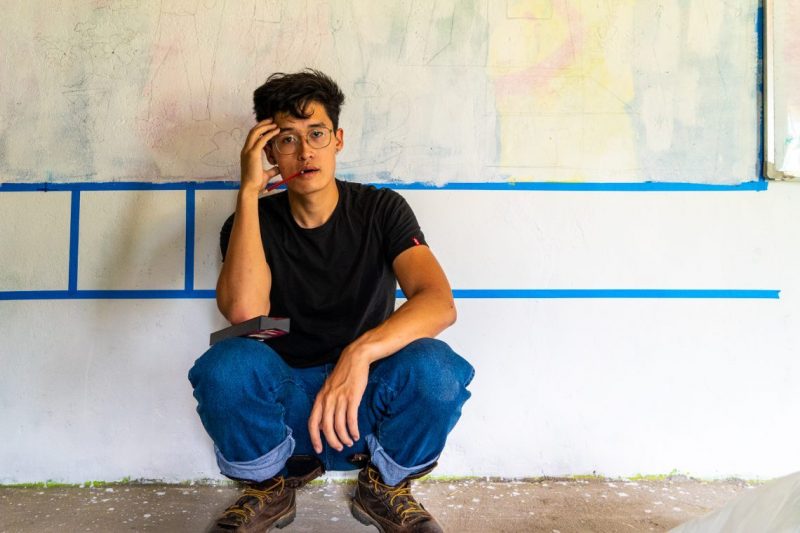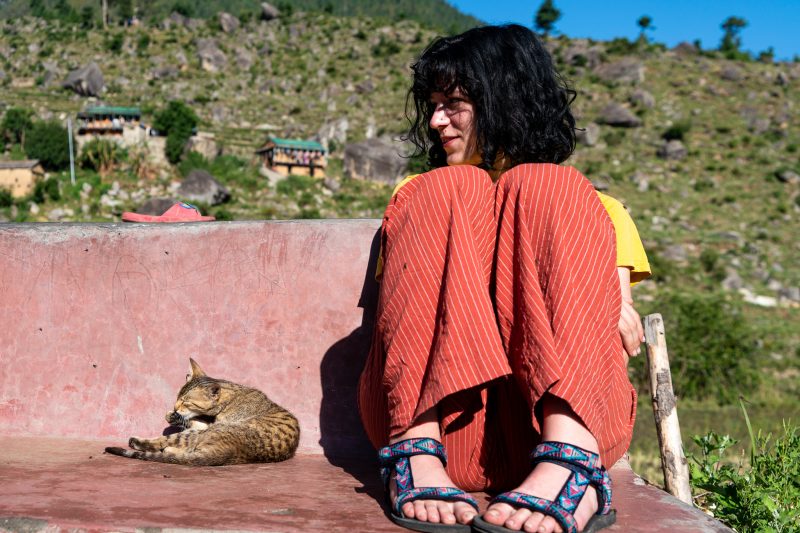
‘Intellectual Curiosity Without Boundaries’ James Ricks '21 is spending the summer working for The Oda Foundation in Nepal, where he is researching tobacco use and working with children to create a mural that represents health in their town.
“All of the work I’m doing here, from photography to mural-making, is related to health, and I’m reminded how crucially health depends on many other unseen factors.”
~ James Ricks ’21
Hometown: Seattle, Washington
Major: English, Pre-Med
Minor: Poverty and Human Capability Studies
What factors led you to choose W&L?
Great academics, great culture, great financial aid—and the Shepherd Program, which promised a challenging and exciting lens through which to study poverty as a complex social crisis.
What made you decide on your major and minor?
For English, I love reading and the great conversations we have in class surrounding really complex, difficult topics. I’ve wanted to work in medicine for a long time now, and I look forward to medical school after graduation.
The Shepherd Program for me was a no-brainer. Poverty is an incredibly complex, multifaceted topic, and the multidisciplinary approach of the minor immediately enticed me and has given me new ways to think about and approach the topic.
Where are you spending your summer and what are you doing there?
I’m spending my summer in Odanaku, a small town in the western Kalikot region of Nepal. I’m working with The Oda Foundation, which was founded back in 2013 by W&L alum John Christopher ’09. The foundation provides crucial medical and educational support to the region, supplying local schools with resources and teaching staff and running the only clinic within 5-7 hours’ distance. While here, I’ll be working on a few different projects that dovetail into the work that the foundation does at large.
Tell us a bit about those projects.
The first of these is a research project investigating the cultural context and social determinants of tobacco use in Odanaku. Tobacco use in Nepal at large is quite widespread. Recent data suggest that as many as one in four adult Nepali men use tobacco regularly, with women and youth numbers not far behind. Particularly concerning is the large spike in frequency of tobacco use between adolescent and adult ages. What’s more, the demographic breakdown places the burden of those numbers on populations of lower socioeconomic status and educational attainment.
This all considered, youth in Odanaku are at special risk for tobacco use, as many of the town’s residents have not had the opportunity to receive substantial formal education, and they belong to the lowest caste in Nepal, placing them at the intersection of those troubling social determinants. To that end, I’m interviewing youth ages 15- to 19-years-old about their perspectives on tobacco use, aiming to produce a more nuanced picture of tobacco use in towns like Odanaku and inform interventions by The Oda Foundation’s educational arm to educate against tobacco use.
The second of the projects I’m working on marries those health and education focuses in the form of a health class taught through mural-making. I’ve partnered with health professionals in the foundation’s clinic and women’s empowerment departments to teach local youth about the complexity of health as a physical, mental, emotional and social state. The youth, in turn, are using those lessons to help me create a mural that represents health in Odanaku. From the ground up, the mural is designed by the students, who also will help me do the majority of the painting.
There are a couple guiding reasons for approaching a health course this way. First, health education lectures when I was in high school were not terribly interesting. I wanted to find a way to teach health in a way that engaged students. More than engaging students, however, making the mural this way allows students to take ownership of health—to not only internalize it but to express it in their own terms through their own unique experiential lenses. Furthermore, the mural is being painted in a classroom that currently houses weekly youth group meetings, encouraging the further claim to that space as their own.
What else are you experiencing in Nepal?
Those larger projects aside, I’m also doing a lot of shadowing in the clinic. I’m hoping when I’m finished with medical school to work in rural medicine, so I’ve been very lucky to spend my downtime following the practitioners working here. The passion and care with which they approach medicine is inspiring, and the amount of good they accomplish here is immeasurable. I’m also generating media for The Oda Foundation, creating collections of images surrounding different services and staff here to aid in social media production and outreach.
Did any special funding make it possible for you to do this experience?
The Shepherd Program, Johnson Enhancement Fund, Art History Department, and Center for International Education provided crucial funding for these projects.
What has been the most fun or rewarding part about the work you’re doing this summer?
The most exciting part of my work is building relationships with people here. The work the foundation does is predicated on community, so to live and work here is to be part of that community oneself. If I want to hold a youth group meeting, I walk into town and visit the schools and families of children that I think will be interested. I follow the medical staff in the morning and have dinner and spend time with them in the evening. I even do a morning workout routine with the clinic manager. People live very close here. Photography similarly relies on intimacy. It’s often said that it’s more important to “click” with the subject of your photograph than to “click” the shutter. I enjoy the ways that my work demands strong relationships but builds them as well.
Do you think your work this summer will impact your career goals?
This summer’s work reaffirms my desire to work in rural medicine, and to work with people. The patients in this area need care, and the services here are absolutely indispensable to the community. Some patients walk as far as seven hours to seek care. To be a part of providing such critical access would be extremely rewarding. What’s more, the unique challenges posed by rural medicine are exciting, and to be a part of a team like the one here in Odanaku would be an incredible experience.
Moreover, I’m reminded of how complex health is, especially in a setting like this. All of the work I’m doing here, from photography to mural-making, is related to health, and I’m reminded how crucially health depends on many other unseen factors.
Has anyone on campus served as a mentor to you?
Many people have—more than I can list here. There a few individuals without whom none of this work would have been possible. Professor Harvey Markowitz of the Sociology/Anthropology Department was extremely patient and helpful in assisting me with the planning of my research project. Professor Andrea Lepage of the Art and Art History Department provided me with a plethora of resources and time. It was only in the Spring Term that I began to realize what an undertaking the mural would be, but her guidance and help has made all the difference. I learned the very model of mural-making education from her, as she has utilized it in her Community Muralism course and elsewhere. Last but not least, the Shepherd Department as a whole has been extremely helpful, providing all kinds of support and letting me drop by and bounce ideas off as I’ve been planning this summer on-and-off for the last two years.
What would you say to a W&L student who is deciding whether to apply or attend here?
Apply! Attend! I am neither an art history nor an anthropology major, yet my work this summer is grounded in both. Being a student at W&L comes with the freedom to pursue intellectual curiosity without boundaries. The faculty here, from many different departments, have made all the difference in helping me accomplish this work, and I can’t imagine where I’d be without their support.
Learn more about The Oda Foundation.
If you know any W&L students who would be great profile subjects, tell us about them! Nominate them for a web profile.
More about James
What is your personal motto?
What would Dr. U. do?
If you could recommend one film or book to everyone, what would it be?
“The Darjeeling Limited,” or anything by filmmaker Wes Anderson
Favorite W&L event?
I love Nabors Service Day!
What’s something most people don’t know about you?
I spent 10 months living in Nepal during my gap year
Favorite class?
Justice, Love and Forgiveness taught by Professor Howard Pickett at Augusta Correctional Center
What are your post grad plans?
Medical school! Take pictures! Drink tea.
 James Ricks ’21 in Odanaku, Nepal
James Ricks ’21 in Odanaku, Nepal Danika Brockman ‘21 is also in Nepal this summer doing research on women’s reproductive health.
Danika Brockman ‘21 is also in Nepal this summer doing research on women’s reproductive health.
You must be logged in to post a comment.